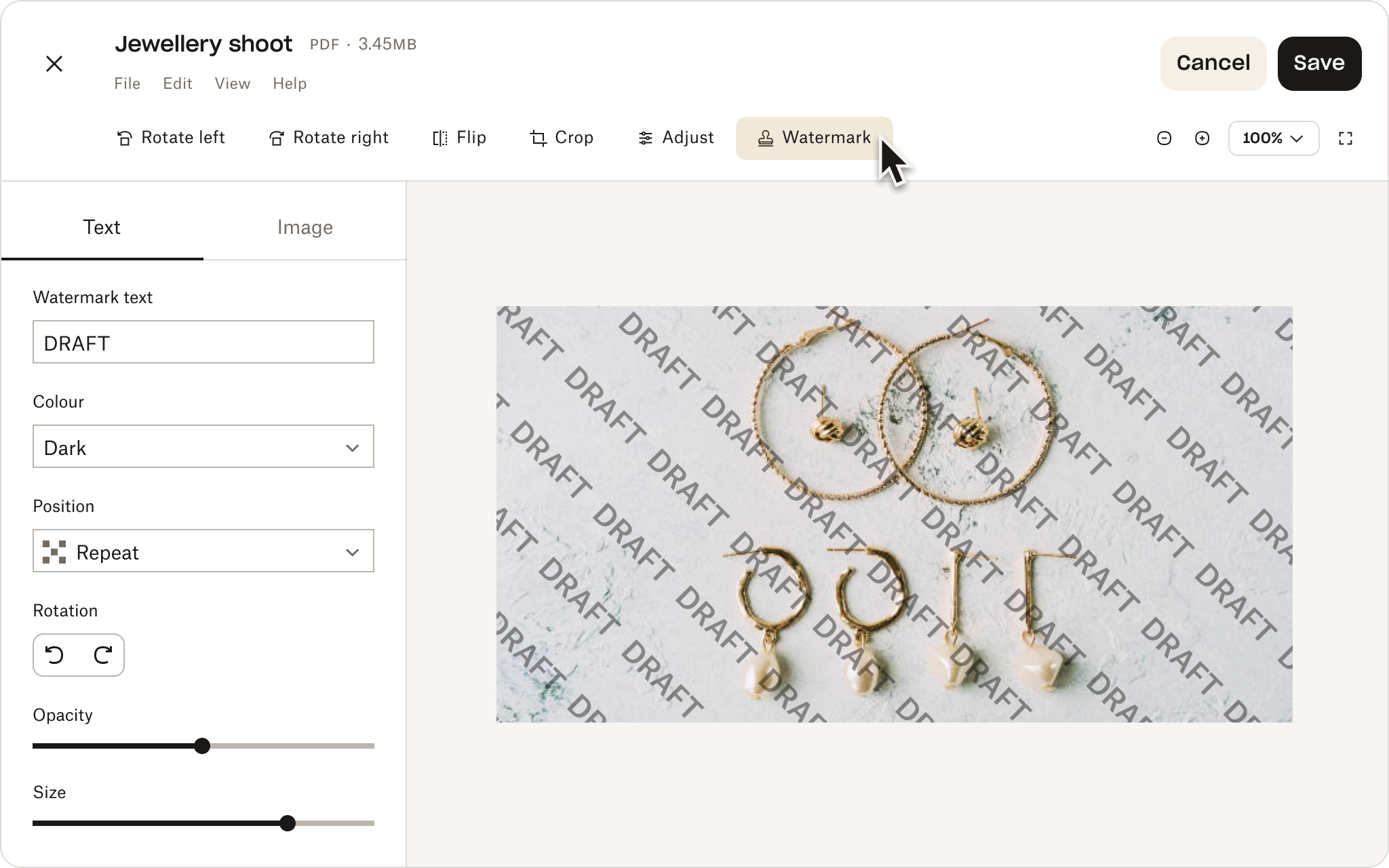Table of contents
- What is watermarking?
- Why watermarking matters
- Types of watermarks and their uses
- When and where to use watermarks
- How to add a watermark to photos and PDFs on Dropbox
- Step-by-step guide to watermarking videos with Dropbox Replay
- Tips for effective watermark placement
- Do more than just store (or add) watermarks
What is watermarking?
Watermarking is the process of superimposing or embedding a visible (or invisible) identifier, such as a logo or unique code, into digital content. This embedded mark serves as a means of identification and ownership, providing a layer of protection against unauthorised use.
By incorporating watermarks into your digital assets, you can make it much harder for others to try and copy your work without permission. And if they do? That watermark is going to make it very obvious they’ve stolen that work from you and your brand!
Ultimately, whether you're a photographer, designer, filmmaker or software developer, watermarking provides a reliable means of protecting your intellectual property. And you deserve that after the hard work you put in.
What does “watermark” mean?
While the watermarking process is mostly digital these days, the term "watermarking" itself dates back centuries. Traditionally, a watermark was only visible when the paper was held up to the light or when it was wet and the process of watermarking paper occurred while the paper was wet—hence the term we still use today.
Why watermarking matters
The internet makes sharing information easy, which can be a wonderful thing. However, it also increases the risk of unauthorised use and copyright infringement. Watermarking addresses these challenges by helping protect your intellectual property.
Using watermarks to protect your digital content offers a range of benefits that can greatly enhance your security and content management strategies. So, why should you consider implementing watermarks?
1. Deterrence against unauthorised use
Document watermarks act as a visible deterrent, signalling ownership and reducing the likelihood of unauthorised use or illegal distribution.
2. Enhanced security
Watermarks add a layer of security, making it difficult for unauthorised users to claim ownership or remove the mark, thus maintaining control over your content.
3. Tracking and monitoring
By embedding unique watermarks in each copy of your digital asset, you can track distribution and usage, monitor the reach and impact of your content and identify potential copyright violations.
4. Brand recognition and awareness
Watermarks reinforce your brand identity, subtly promoting your brand every time your watermarked content is viewed or shared, expanding your reach and strengthening your brand presence.
Watermarking is versatile, with various types tailored to different security needs and content formats. Understanding these types helps you choose the most effective method to protect and manage your digital assets.
Types of watermarks and their uses
Watermarks can be categorised into several types, each serving specific purposes and offering varying levels of protection:
Visible watermarks
Visible watermarks are the most common type of watermark and are often used to deter unauthorised use of content. Typically, visible watermarks consist of text or logos superimposed on the content, making it clear that the material is protected.
Invisible watermarks
Invisible watermarks are more difficult to detect and are often used to track the ownership of content. They are typically embedded within the content itself and are not visible to the naked eye.
Invisible watermarks can be used to track ownership and movement of content across the internet. They are useful for copyright protection and identifying the source of unauthorised copies using specialised software.
Digital watermarks
Digital watermarks are used to protect digital content, such as images, videos and music and are resistant to removal or alteration. They are typically embedded within the content itself and can be used to protect content, track ownership and prevent unauthorised use. You can also add additional information, such as creation date and time.
Forensic watermarks
Forensic watermarks are used to identify the source of content and provide evidence in legal proceedings. They are typically embedded within the content itself and are not visible to the naked eye.
These watermarks contain hidden information, such as the creator's identity or the date of creation, and can be used to track the movement of content across the internet.
Holographic watermarks
Holographic watermarks employ holographic technology to create three-dimensional images that appear to change when viewed from different angles.
These watermarks are commonly used on high-value items, such as currency, passports and official documents, to deter counterfeiting and provide enhanced security.
Robust watermarks
In addition to these primary types, there are also robust watermarks, which are designed to withstand various transformations, such as resizing, compression or cropping, making them more resilient against unauthorised modifications.
By selecting the appropriate type of watermark, you can ensure the security and integrity of your digital assets across various platforms and uses.

When and where to use watermarks
You can use watermarks on any content you want to protect from unauthorised use, such as images, photos, videos, documents and PDFs. They can also be applied to content that you want to promote or track, which may include social media posts, blog articles or even website content.
Images and photos
Watermarks can be an effective way to protect your copyright and ownership of your images and photos. If you are planning to share your images and photos online, it’s highly important to think about how you will prevent unauthorised use of your work.
Videos
Protect your copyright and ownership of your videos with a video watermark. If you plan to share your videos on YouTube or other video-sharing platforms, this can help to ensure you still get credit in the event the video is re-uploaded without permission.
Documents and PDFs
Document watermarks help to protect your copyright and ownership of your documents and PDFs. This is especially important if you plan to share your documents and PDFs online.
Social media posts
It isn’t just about protection, watermarks can help you to promote your brand or website on social media posts as well. If you’re producing great content and it gets shared beyond your account, people will still know where it came from. This is a great way to reach new customers and grow your audience.
How to add a watermark to photos and PDFs on Dropbox
You can use Dropbox to watermark your files, ensuring that your content remains protected and secure. Dropbox allows you to enable customisable watermarking for any JPEG, PNG, BMP or PDF file, all in just a few simple steps:
- Log in to your Dropbox account.
- Once logged in, navigate to the file you want to watermark.
- Click the three dots next to the file name and select Watermark
- Choose the type of watermark you want. You can add text, images or logos and customise it according to your preferences.
- Adjust the position and size of the watermark as desired.
- Click Apply to add the watermark to your file.
To watermark multiple files at once, select the folder containing the files you want to protect. Follow the same steps as above and click Apply to all to add the watermark to all the files in the folder.

Step-by-step guide to watermarking videos with Dropbox Replay
In addition to traditional watermarking techniques, Dropbox Replay also offers dynamic watermarking specifically designed for videos.
Watermarking with Replay works by embedding a unique, imperceptible watermark into the video stream. This watermark can then be detected by authorised devices or software, allowing you to track and monitor the distribution of your video content.

How to watermark videos with Dropbox Replay
- Log in to dropbox.com and click Replay from the menu that appears in the top-left corner.
- Open the Replay file you’d like to add a watermark to and click the Watermark tab.
- If you haven’t created a watermark yet, click + New Link.
- Customise watermark settings. To do this, adjust the settings under the Customise tab:
- Display text: Choose from recipient’s email, recipient’s IP address, view date, view time or custom text.
- Position: Select left, centred or right.
- Theme.
- Opacity.
- Size.
- Click the Settings tab and enable any desired settings:
- Allow downloads.
- Require password: Type a password for all watermarked links in that Replay file.
- Assign due date: Type in date and time.
- Enable link access.
- Require Dropbox login.
- Click Save.
By utilising the Dropbox Replay watermarking feature, you can safeguard your video content, monitor its distribution and protect your intellectual property effectively.
How to customise a watermark in Dropbox Replay
- Customise fonts, colours and sizes for your text/ logo watermark to match your brand or personal preference.
- Adjust the transparency to control visibility to make it as prominent or subtle as you like.
- Upload your own custom image or choose from a variety of pre-designed templates to create a unique watermark.
Tips for effective watermark placement
When it comes to watermark placement, there are a few key things to keep in mind to ensure that your watermark is effective in protecting your content and deterring unauthorised use. It’s important to strike a balance that works for you based on what you’re watermarking and why you’re watermarking it.
Visibility without distraction
Ensure your watermark is noticeable but not intrusive, allowing viewers to focus on the content itself.
Strategic positioning
Place your watermark in corners or along edges to make it difficult to remove or alter without affecting the content.
Relevance to content
Use a watermark that aligns with your content, such as a logo or signature for artwork, to protect and reinforce your branding.
Consistency across content
Use the same watermark on all your images, videos and documents to create a cohesive brand identity and reinforce ownership.
Following these tips will help your watermark protect your content effectively while maintaining its integrity and usability.
Beyond watermarking, Dropbox offers a suite of features that can enhance your workflow and protect your content.
Do more than just store (or add) watermarks
While watermarking is a valuable tool for deterring unauthorised use, it's just one piece of the puzzle. Dropbox offers a robust suite of features that work together to safeguard your content and streamline your workflow.
With file sharing and granular permission controls, secure storage and automatic syncing, real-time collaboration and access to previous file versions, Dropbox provides robust protection for your digital assets. Additionally, advanced security measures like two-factor authentication and secure link sharing ensure your content remains protected.
A well-rounded content protection strategy goes beyond visibility. Dropbox empowers you to not only deter unauthorised use but also manage your files effectively and securely. Start using Dropbox today to enhance your workflow and protect your valuable digital creations.
Ready to protect your digital creations? Start adding watermarks to your assets today to safeguard your work and enhance your brand’s visibility.


